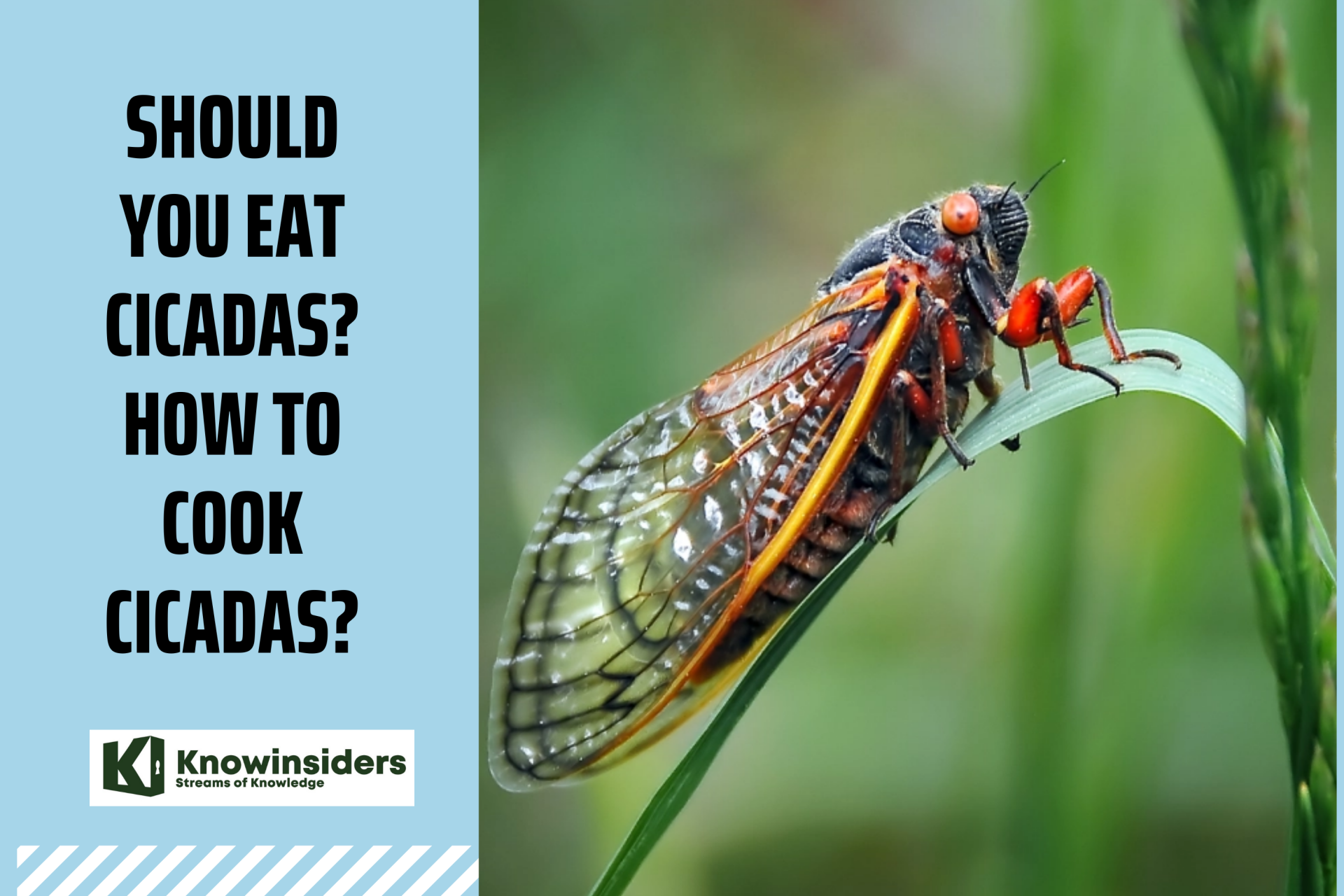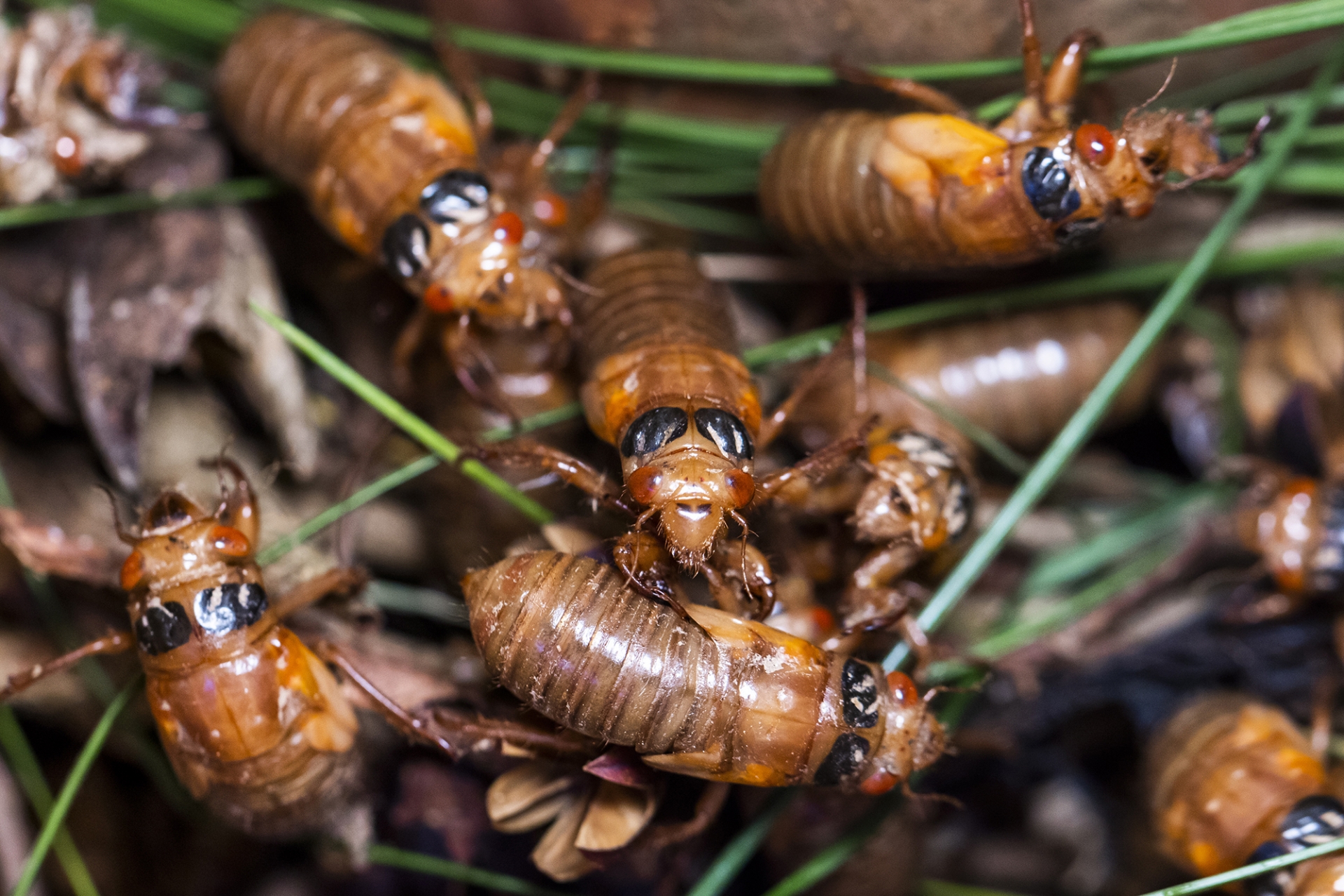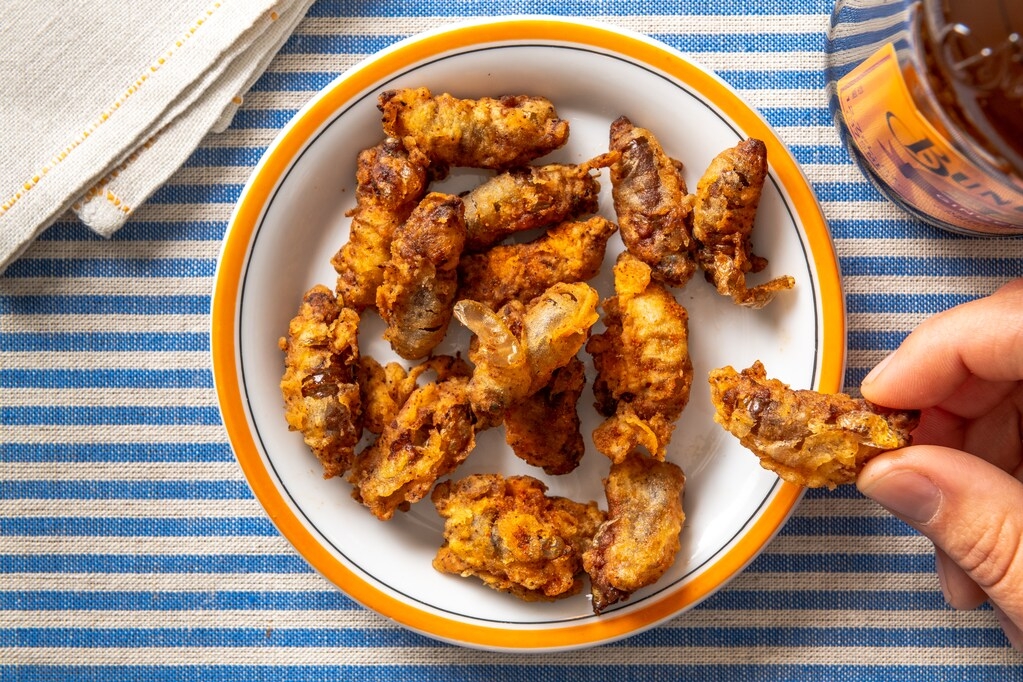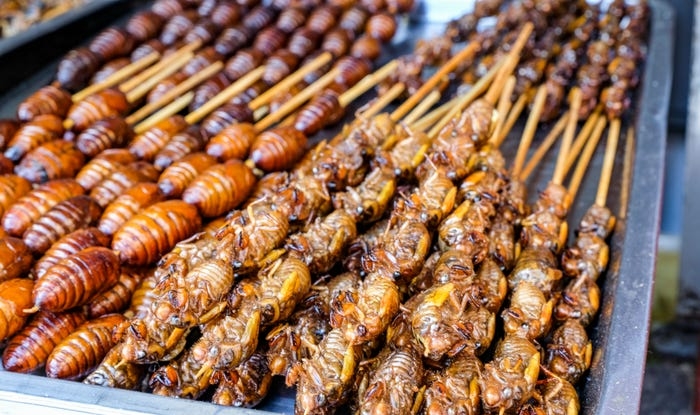Should You Eat Cicadas and How To Cook Cicadas?
 |
| Cicadas. Photo: KnowInsiders |
Why do some people eat cicadas?
In the United States, we’re socialized to think of bugs (especially giant ones like cicadas) as nasty—definitely not something to eat. But if you come at it from another perspective, cicadas are like a huge surplus of free food that you don’t need to buy at the store.
The bugs are a great source of sustainable protein, according to Akito Y. Kawahara, Ph.D., associate professor and curator at the Florida Museum of Natural History at the University of Florida. Producing meat like beef requires a great deal of land, feed, and emission, contributing to climate change; insects like cicadas, meanwhile, are a source of food without all that baggage. “These are opportunities that we should probably take advantage of,” he says.
There is limited nutritional data on cicadas, but experts suspect it is similar to that of other insects, offering plenty of protein with relatively few calories. Bugs also offer healthy amounts of fiber, fat, vitamins, and minerals, per an expansive United Nations (UN) report from 2013—and cicadas are likely no exception.
How to collect cicadas
These thumb-sized insects will come up for air as soon as ground temperatures reach around 64 degrees Fahrenheit, which is due to happen in mid-May, depending on where you are. The up-to-100-decibel buzzing will follow shortly thereafter, likely lasting through late June.
During that time, you can roll up your sleeves and pick up some cicadas for a nutritious snack.
Location, location, location
If you live in one of the 15 states where Brood X will emerge, you’ll probably see these insects flying around anywhere vegetation has found space to grow. But if you’re looking to eat them, you’ll have to be a little more discerning.
“If I’m walking down Main Street and there’s a bunch of cicadas, I probably won’t feel so good about collecting them there,” says Joseph Yoon, a chef, the founder of Brooklyn Bugs, and an entomophagy advocate. If you’re not careful, you could end up eating pesticides, dirt, small bits of litter, or even someone else’s spit.
The best places to pick up cicadas are more secluded areas that have not been treated with pesticides, fertilizers, or other chemicals. These could include your own backyard or a spot in the countryside you have access to. You don’t need a perfectly organic piece of land, though. Gardening chemicals are not automatically bad, so asking somebody who knows about any such substances in the soil will help you decide if you feel comfortable eating from that area.
You should also consider that cicadas molt. When they first emerge as nymphs, cicadas are soft and have no exoskeleton. This changes as they climb trees, turn into adults, and shed their casing. This also means that any external part of the cicada that might have been in contact with polluted soil is discarded, minimizing the risk you might ingest something toxic.
Finally, if you’re thinking about hitting your local park to get dinner, make sure it’s not against the law. In most public green areas throughout the country, you’ll need a permit to harvest, forage, or collect anything from plants to bugs.
Timing is everything
 |
| Photo: New York Post |
The different stages of a cicada’s life cycle will determine what type of food you get and how you can prepare it. Think of it as the difference between eating an egg or a chicken thigh.
If you’re lucky, you might be able to spot some cicadas as they emerge from the ground. But don’t pick them up just yet, says Yoon.
“If you wait a day or hours after, they’re going to molt. And yum! They’re going to be a delicacy,” he says.
Freshly molted cicadas will be clean, smooth, and soft. At this stage, the earlier you catch them, the better, as they’ll lose muscle mass the older they get. The window of opportunity to get fat, juicy cicadas at this stage is narrow though, so you’ll need to monitor the ground temperature regularly, and observe what these red-eyed bugs are up to.
If you miss your chance, you can always collect adult cicadas. They’ll be flying around, singing, and calling for mates. It’ll just be a matter of catching them mid-flight or waiting for them to bump into you.
After they mate, male cicadas will die and fall to the ground. You might think this is the best time to pick them up, as they have already fulfilled their destiny and are literally just lying there, looking like a snack.
Unfortunately, unless you actually witness a cicada’s last chirp, there’s no way to know how long the bug has been dead, and therefore, how decomposed it is. Just as you would not eat a flattened squirrel off the roadside or a dead deer you found in the woods, it’s a good idea to stick to living insects.
Gear up
Cicadas are harmless, so there’s no need to cover your face or hands for safety. If you feel uncomfortable handling them with your bare skin, though, latex gloves are a good choice, as you won’t lose any dexterity and will be able to easily pick up your bugs.
The main risk cicadas pose is to your ears. They’re loud. So loud, in fact, that the sheer volume of their song is comparable to that of a lawn mower. Ear plugs or noise-canceling headphones will help, and will hopefully prevent you from feeling overwhelmed by the swarm of bugs.
Depending on the time of day you decide to collect cicadas, you may want to have a flashlight or, better yet, a headlamp. Light will be especially handy if you’re digging in the ground for nymphs.
You should also be aware of other crawlers out there. Tick season seems to have come early in some parts of the east, so make sure to wear your socks over your pants and cover your arms to prevent these bloodsuckers from digging into you.
Mosquitoes may also be an issue where you live. If you choose to fight them with bug repellent, make sure to wash your hands thoroughly and wear gloves when you hunt your cicadas. You are, after all, handling food. The last thing you want is for any of that chemical bug spray to make it to your plate.
Whether you’re picking cicadas off tree trunks or using a butterfly net to catch them, you’ll want to stash them in a paper or fabric bag. This will prevent them from suffocating, which causes unnecessary stress and the release of chemicals that may affect their flavor, explains Yoon.
You’ve got your cicadas. Now what?
This is the hard part. Now that you’ve collected your cicadas, you’ll have to kill them. Just as you would with any other animal, you should respect the life that you’re taking and be as quick and gentle as possible to give the insects a humane death.
In the field, Yoon suggests bringing a cooler filled with ice to store cicadas. The temperature probably won’t be low enough to kill the insects, but it will numb them enough so you can easily handle them.
Once you’re home, take them out of the cooler and put them in a row over a baking sheet. Then store them in the freezer for a couple of hours. This, according to Yoon, is one of the best ways to euthanize an insect, and it’s used by cricket farmers all the time.
If you’re wary about having loose cicadas in your freezer, you can put them in a plastic container. Don’t wash them before you do, though. If they move, they will clump up.
An alternative to this is to blanch them as you would a lobster. This means killing your cicadas by submerging them in boiling water for two minutes. After you’re done, place your cicadas in rows on a baking sheet and let them cool down to room temperature.
The upside to boiling is that once your insects are dry, they’ll be good to go, as the heat will have also killed any undesirable bacteria.
How to Cook Cicadas
| NOTE: Cicadas are edible, but if you have allergies to soy, nuts or shellfish, or any contact allergies to other insects, experts say to consult your doctor before consuming. The creatures do not contain any toxic substances, but accumulation of pesticides and other chemicals is possible. Unless one binges on cicadas, however, experts say this should not be a concern. |
 |
| Photo: washingtonpost |
Ingredients to Cook Cicadas
For the cicadas
12 freshly emerged 17-year cicadas
1/2 cup Worcestershire sauce
1/4 cup all-purpose flour
1/4 teaspoon onion powder
1/4 teaspoon garlic powder
1/4 teaspoon sweet or smoked paprika
1/8 teaspoon fine sea salt
1/8 teaspoon cayenne pepper
1 large egg
Vegetable oil, for frying
For the spice mix
1/2 teaspoon ground cumin
1/4 teaspoon fine sea salt
1/4 teaspoon cayenne pepper
Step 1
Place the live cicadas in an airtight container and freeze at least 3 hours, or overnight.
Step 2
Thoroughly rinse the frozen cicadas to remove any dirt, then transfer to a small bowl, pour the Worcestershire sauce over them and stir to combine. Cover and refrigerate for about 1 hour.
Step 3
Remove the cicadas from the Worcestershire sauce and transfer to a wire rack or a towel-lined plate to drain.
Step 4
Set out two shallow bowls. In one, whisk together the flour, onion powder, garlic powder, paprika, salt and cayenne; in the other, whisk the egg.
Working with one cicada at a time, dip it into the egg, letting the excess drip off, then coat it in the flour mixture, shaking off any excess, and transfer to a plate. Repeat with the remaining cicadas.
Step 5
In a small saucepan, add enough oil to come about 1 1/2 inches up the sides of the pan, about 1 1/2 cups. Set the pot over medium-high heat and warm the oil until it registers 350 degrees on an instant-read thermometer. Place a wire rack near the stove or line a large plate with a clean tea towel or paper towels.
Step 6
Make the spice mix: In a small bowl, whisk together the cumin, salt and cayenne.
Step 7
Fry the cicadas in two batches, 6 or so at a time, until light golden and crispy. Once they float to the surface, watch them carefully to avoid burning, stirring occasionally with a slotted spoon so they brown evenly, about 2 minutes. Transfer to the prepared rack or plate.
Step 8
Lightly sprinkle the hot cicadas with the spice mixture as soon as they are removed from the oil. Transfer the cooked cicadas to a small bowl and serve.
What do cicadas taste like?
 |
| Photo: Insider |
Like other proteins, cicadas take on a rich flavor when cooked. Home chefs on social media describe the taste as buttery or nutty—better than you might expect from an insect. One TikTok user describes the taste of boiled cicadas as akin to fiddleheads, while roasted cicadas take on a nuttier flavor.
Is eating bugs safe?In short, yes. Although they aren’t a common part of the American diet, insects are a staple in tons of other places; at least 2 billion people worldwide regularly consume bugs in their diets, and more than 1,900 insect species have reportedly been used as food, according to the UN report. People eat insects just about everywhere, from Mexico to Australia to Thailand, “both as a delicacy and staple,” per Cicada-licious. Cicadas, specifically, are also a cherished ingredient of some regional Chinese cuisines, Kawahara says, where tenerals are harvested and added to dishes like stir-fries. You’re also probably eating bugs without knowing it, since bits and pieces of insects inevitably end up in the food we eat. Carmine, one of the most commonly used red food dyes, is made from crushed beetles. Again, exercise caution before indulging in cicadas if you have a seafood allergy. There is also very little chance that eating cicadas, particularly periodical cicadas, will impact their survival, Kawahara explains: “There are just so many that I don’t think small amounts of eating them is going to really affect anything,” he says. Bottom line? “There is no reason why we should not be eating insects,” explains Kawahara, who hopes we can stop thinking of bugs as gross. “If you think of it from a different perspective, the fact that we drink cow’s milk—which is coming out of the breast of a cow—it’s pretty gross, I think.” Food for thought! |
 How To Make Fake or Artificial Snow On Christmas? How To Make Fake or Artificial Snow On Christmas? Let it snow with this simple Christmas activity that younger children especially will love! Check out some useful tips to make fake snow for decorations. |
 Easy Steps to Make a Pineapple Upside Down Cake Easy Steps to Make a Pineapple Upside Down Cake This classic cake forever remains a favorite dessert for all generations. What are you waiting for? Check the information given below and start making one ... |
Singapore's Bak Kut Teh is a version of pork ribs tea with a clear garlicky and peppery broth. Only a few ingredients and very easy ... |


























